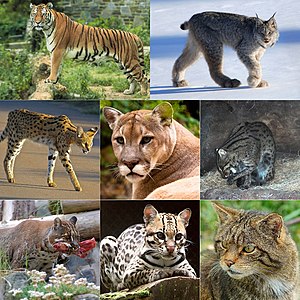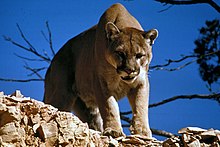The Cats PortalFelidae ( /ˈfɛlɪdiː/) is the family of mammals in the order Carnivora colloquially referred to as cats. A member of this family is also called a felid ( /ˈfiːlɪd/). The term "cat" refers both to felids in general and specifically to the domestic cat ( Felis catus). The 41 extant Felidae species exhibit the greatest diversity in fur patterns of all terrestrial carnivores. Cats have retractile claws, slender muscular bodies and strong flexible forelimbs. Their teeth and facial muscles allow for a powerful bite. They are all obligate carnivores, and most are solitary predators ambushing or stalking their prey. Wild cats occur in Africa, Europe, Asia and the Americas. Some wild cat species are adapted to forest and savanna habitats, some to arid environments, and a few also to wetlands and mountainous terrain. Their activity patterns range from nocturnal and crepuscular to diurnal, depending on their preferred prey species. ( Full article...) Selected species -The cougar (Puma concolor) ( /ˈkuːɡər/, KOO-gər), also known as the panther, mountain lion, catamount and puma, is a large cat native to the Americas. It inhabits North, Central and South America, making it the most widely distributed wild, terrestrial mammal in the Western Hemisphere, and one of the most widespread in the world. Its range spans the Canadian Territory of Yukon, British Columbia and Alberta provinces, the Rocky Mountains and areas in the Western United States. Further south, its range extends through Mexico to the Amazon Rainforest and the southern Andes Mountains in Patagonia. It is an adaptable, generalist species, occurring in most American habitat types. It prefers habitats with dense underbrush and rocky areas for stalking but also lives in open areas. The cougar is largely solitary. Its activity pattern varies from diurnality and cathemerality to crepuscularity and nocturnality between protected and non-protected areas, and is apparently correlated with the presence of other predators, prey species, livestock and humans. It is an ambush predator that pursues a wide variety of prey. Ungulates, particularly deer, are its primary prey, but it also hunts rodents. It is territorial and lives at low population densities. Individual home ranges depend on terrain, vegetation and abundance of prey. While large, it is not always the dominant apex predator in its range, yielding prey to other predators. It is reclusive and mostly avoids people. Fatal attacks on humans are rare but increased in North America as more people entered cougar habitat and built farms. ( Full article...) List articles
Related portalsWikiProjectsSelected breed -The Persian cat, also known as the Persian Longhair, is a long-haired breed of cat characterised by a round face and short muzzle. The first documented ancestors of Persian cats might have been imported into Italy from Khorasan as early as around 1620, however, this has not been proven. Instead, there is stronger evidence for a longhaired cat breed being exported from Afghanistan and Iran from the 19th century onwards. Widely recognised by the North-West European cat fancy since the 19th century, and after World War II by breeders from North America, Australia and New Zealand. Some cat fancier organisations' breed standards subsume the Himalayan and Exotic Shorthair as variants of this breed, while others generally treat them as separate breeds. The selective breeding carried out by breeders has allowed the development of a wide variety of coat colours, but has also led to the creation of increasingly flat-faced Persian cats. Favoured by fanciers, this head structure can bring with it several health problems. As is the case with the Siamese breed, there have been efforts by some breeders to preserve the older type of cat, the Traditional Persian, which has a more pronounced muzzle. Hereditary polycystic kidney disease (PKD) is prevalent in the breed, affecting almost half of the population in some countries. ( Full article...) Did you know... -
TopicsAssociated WikimediaThe following Wikimedia Foundation sister projects provide more on this subject:
Discover Wikipedia using
portals |
The Cats PortalFelidae ( /ˈfɛlɪdiː/) is the family of mammals in the order Carnivora colloquially referred to as cats. A member of this family is also called a felid ( /ˈfiːlɪd/). The term "cat" refers both to felids in general and specifically to the domestic cat ( Felis catus). The 41 extant Felidae species exhibit the greatest diversity in fur patterns of all terrestrial carnivores. Cats have retractile claws, slender muscular bodies and strong flexible forelimbs. Their teeth and facial muscles allow for a powerful bite. They are all obligate carnivores, and most are solitary predators ambushing or stalking their prey. Wild cats occur in Africa, Europe, Asia and the Americas. Some wild cat species are adapted to forest and savanna habitats, some to arid environments, and a few also to wetlands and mountainous terrain. Their activity patterns range from nocturnal and crepuscular to diurnal, depending on their preferred prey species. ( Full article...) Selected species -The cougar (Puma concolor) ( /ˈkuːɡər/, KOO-gər), also known as the panther, mountain lion, catamount and puma, is a large cat native to the Americas. It inhabits North, Central and South America, making it the most widely distributed wild, terrestrial mammal in the Western Hemisphere, and one of the most widespread in the world. Its range spans the Canadian Territory of Yukon, British Columbia and Alberta provinces, the Rocky Mountains and areas in the Western United States. Further south, its range extends through Mexico to the Amazon Rainforest and the southern Andes Mountains in Patagonia. It is an adaptable, generalist species, occurring in most American habitat types. It prefers habitats with dense underbrush and rocky areas for stalking but also lives in open areas. The cougar is largely solitary. Its activity pattern varies from diurnality and cathemerality to crepuscularity and nocturnality between protected and non-protected areas, and is apparently correlated with the presence of other predators, prey species, livestock and humans. It is an ambush predator that pursues a wide variety of prey. Ungulates, particularly deer, are its primary prey, but it also hunts rodents. It is territorial and lives at low population densities. Individual home ranges depend on terrain, vegetation and abundance of prey. While large, it is not always the dominant apex predator in its range, yielding prey to other predators. It is reclusive and mostly avoids people. Fatal attacks on humans are rare but increased in North America as more people entered cougar habitat and built farms. ( Full article...) List articles
Related portalsWikiProjectsSelected breed -The Persian cat, also known as the Persian Longhair, is a long-haired breed of cat characterised by a round face and short muzzle. The first documented ancestors of Persian cats might have been imported into Italy from Khorasan as early as around 1620, however, this has not been proven. Instead, there is stronger evidence for a longhaired cat breed being exported from Afghanistan and Iran from the 19th century onwards. Widely recognised by the North-West European cat fancy since the 19th century, and after World War II by breeders from North America, Australia and New Zealand. Some cat fancier organisations' breed standards subsume the Himalayan and Exotic Shorthair as variants of this breed, while others generally treat them as separate breeds. The selective breeding carried out by breeders has allowed the development of a wide variety of coat colours, but has also led to the creation of increasingly flat-faced Persian cats. Favoured by fanciers, this head structure can bring with it several health problems. As is the case with the Siamese breed, there have been efforts by some breeders to preserve the older type of cat, the Traditional Persian, which has a more pronounced muzzle. Hereditary polycystic kidney disease (PKD) is prevalent in the breed, affecting almost half of the population in some countries. ( Full article...) Did you know... -
TopicsAssociated WikimediaThe following Wikimedia Foundation sister projects provide more on this subject:
Discover Wikipedia using
portals |
























